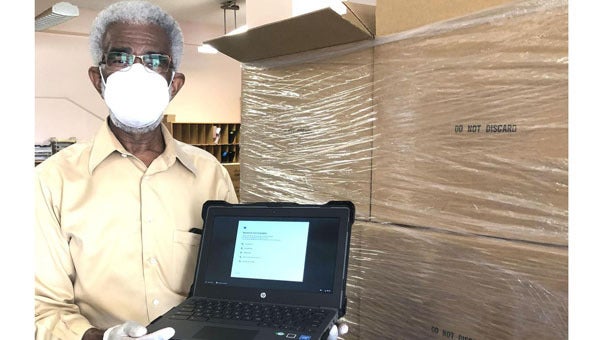Schools to get $31 million for COVID-19
Published 6:58 pm Thursday, May 6, 2021

- Natchez-Adams School District Superintendent Fred T. Butcher holds one of 3,000 Chrome Books the district will be distributed to students in March. (Courtesy NASD)
|
Getting your Trinity Audio player ready...
|
NATCHEZ — The Natchez Adams School District expects to receive more than $31 million in COVID relief funds.
The money is part of the Elementary and Secondary School Emergency Relief Fund, or ESSER fund, part of the CARES Act approved by Congress.
Deputy Superintendent of Natchez Adams School District Zandra McDonald said thus far $2,418,586 has been dispersed to Natchez and Adams County schools from ESSER I, including $185,000 that was provided to Adams County Christian School and Cathedral Schools to cover Title I students, which are disadvantaged and low-income students, served by those schools.
McDonald said $865,000 of the CARES allocation to NASD remains after $1.3 million has been spent on resources for the schools, including Chromebooks, mobile hotspot devices and Canvas and Zoom learning devices for virtual instruction; personal protective equipment, sanitation service and supplies; technology and building infrastructure improvements; food service equipment and supplies; professional development and social workers.
ESSER funds have been used to reimburse costs dating back to March 2020, when a national emergency was declared due to COVID-19, McDonald said.
The district projects it will receive another $9,791,941 from ESSER II and $21,991,309 from ESSER III.
“The (Mississippi Department of Education) has not provided guidance of when those allocations will be deposited into district accounts,” McDonald said. “The submission deadline for applications for ESSER II is May 21. The district has already submitted its application and is awaiting approval. No timeline has been provided for ESSER III funds. The amount provided … is simply a projection.”
McDonald said the school district has through Sept. 30, 2022, to expend ESSER I and will have until 2023 to expend ESSER II and through 2024 for ESSER III.
McDonald said the district is in the process of revisiting a strategic plan for expending the funds and would involve stakeholders, including students, employees, parents and community members, in the planning process.
Currently, the district has a list of needs for the funds which includes air purification systems; child nutrition; digital curriculum; hiring a computer technician, math coaches, and an ESSER asset clerk; increasing services for exceptional students to address their academic, social and emotional needs; learning academies; purchasing additional PPE supplies and further improving the district’s technology infrastructure, bathroom facilities and professional development training.
“The district will release stakeholder engagement surveys that afford members (the opportunity) to review the current strategic plan and provide suggestions for future initiatives,” she said. “We want our stakeholders to know what the plan is, where they fit in it and how they contribute to its goals.”






